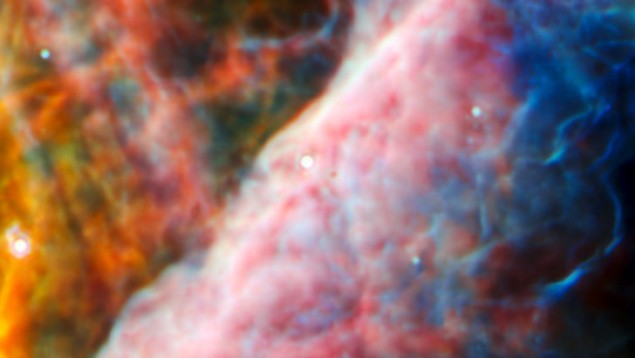JWST spots ionized molecule that could be involved in the emergence of life
25 Jul 2023
Star-forming region: image from the JWST’s Mid-Infrared Instrument shows a small region of the Orion Nebula. At the centre of this image is d203-506, where astronomers have observed methyl cations for the first time in d203-506. (Courtesy: ESA/Webb, NASA, CSA, M. Zamani (ESA/Webb), and the PDRs4All ERS Team)
For the first time, astronomers have observed the signature of methyl cations in a planet-forming disc. Using the James Webb Space Telescope (JWST), a team led by Olivier Berné at the University of Toulouse has shown that methyl cations – an important precursor to complex organic chemistry – are formed in the intense ultraviolet radiation emitted by massive young stars nearby.
In the 1970s astronomers first proposed that the methyl cation molecule (CH3+) could be a key trigger for complex organic chemistry in space – a process that could eventually lead to the emergence of life. Evidence of CH3+ in space could point to the presence of larger molecules – but so far, a combination of factors have meant that CH3+ had not been observed outside the solar system.
The main challenge facing those trying to observe the ion is that CH3+ does not have a permanent dipole moment which makes it invisible to radio telescopes. Alternatively, the ion can be identified from the spectroscopic lines it imprints on infrared radiation. However, these wavelengths are heavily absorbed or scattered by Earth’s atmosphere, making them practically impossible to view from the ground.
Young red dwarf
From its orbit high above Earth, the JWST has now detected this spectroscopic signature in a system called d203-506, which is 1350 light-years away in the Orion nebula. The system comprises a young red dwarf star that is surrounded by a planet-forming disc.
Because CH3+ had been so elusive, Berné’s team struggled to identify the signature, but the team eventually identified it as the first ever detection of interstellar CH3+. “Our discovery was only made possible because astronomers, modellers and laboratory spectroscopists joined forces to understand the unique features observed by James Webb,” explains team member Marie-Aline Martin-Drumel at Paris-Saclay University.
The result is especially fascinating because the Orion nebula is crowded with young, massive stars, which bathe d203-506 in intense ultraviolet radiation. Based on chemical signatures found in meteorites, astronomers now widely believe that planetary systems like the solar system were once bombarded with similar levels of radiation. This radiation may have originated from massive stars, such as those that formed from the same cloud of material that created the Sun. These huge stars then burned out after just a few million years.
Destructive radiation
Although intense ultraviolet radiation is destructive to complex organic molecules, these latest results suggest it could provide the energy needed to ionize methane, triggering the production of CH3+. Another interesting finding was the lack of water detected in d203-506 – which could also be related to high levels of ultraviolet radiation.
“This clearly shows that ultraviolet radiation can completely change the chemistry of a proto-planetary disc,” Berné explains. “It might actually play a critical role in the early chemical stages of the origins of life by helping to produce CH3+ – something that has perhaps previously been underestimated.”
This process could enable more complex molecules to emerge later on, once the massive stars have burned out. At this point the ions could eventually go on to form amino acids, nucleotides, and other key molecular building blocks of life.
Altogether, the result is a key milestone in our understanding of the chemistry of emerging star systems. “This detection of CH3+ not only validates the incredible sensitivity of [the JWST] but also confirms the postulated central importance of CH3+ in interstellar chemistry,” Martin-Drumel says. As JWST continues its exploration of the sky, the team hopes their result will be just the start of a new wave of similar discoveries.
The research is described in Nature.
Sam Jarman is a science writer based in the UK
FROM PHYSICSWORLD.COM 26/7/2023

Δεν υπάρχουν σχόλια:
Δημοσίευση σχολίου